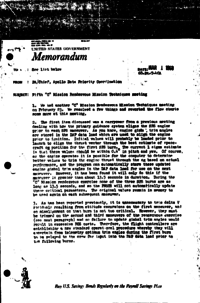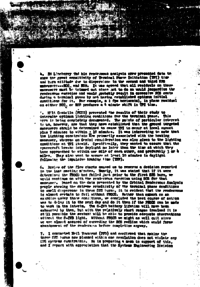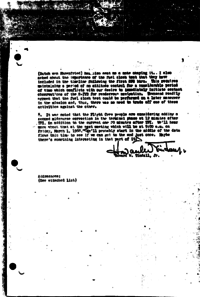Upthread: Fourth Mission “C” Rendezvous Mission Techniques meeting (Feb 21, 1968)
Downthread: Sixth “C” Mission Rendezvous Mission Techniques meeting (Mar 07, 1968)
See list belowMAR 1 196868-PA-T-46APA/Chief, Apollo Data Priority CoordinationFifth “C” Mission Rendezvous Mission Techniques meeting
1. We had another “C” Mission Rendezvous Mission Techniques meeting on February 23. We resolved a few things and reworked the flow charts some more at this meeting.
2. The first item discussed was a carryover from a previous meeting dealing with how the primary guidance system aligns the SPS engine prior to each SPS maneuver. As you know, engine gimbal trim angles are stored in the DAP data load which are used to align the engine prior to ignition. Initial values will probably be loaded prior to launch to align the thrust vector through the best estimate of spacecraft cg position for the first SPS burn. The current 1 sigma estimate is that these values should be within 0.4° in pitch and yaw. Of course, as the engine operates it is possible for the computer to determine better values to trim the engine thrust through the cg based on actual performance, and the program can automatically store these updated engine gimbal trim angles in the DAP data load for use on the next maneuver. However, it has been found it will only do this if the maneuver is greater than about 13.5 seconds in duration. During the “C” Mission rendezvous exercise none of the three SPS burns are as long as 13.5 seconds, and so the PNGCS will not automatically update these critical parameters. The original values remain in memory to be used again on each subsequent maneuver.
3. As has been previously reported, it is unnecessary to trim delta V residuals resulting from attitude excursions on the first maneuver, and so misalignment on that burn is not too critical. However, they must be trimmed on the second and third maneuvers of the rendezvous exercise (see next paragraph) and so failure to update gimbal trim angles would result in excessive RCS costs. Therefore, the flight controllers are establishing a new standard operational procedure whereby they will ascertain from telemetry optimum trim angles during the first burn to be relayed to the crew for input into the DAP data load prior to the following burns.
4. Ed Lineberry and his rendezvous analysis crew presented data to show the great sensitivity of Terminal Phase Initiation (TPI) time and burn attitude due to dispersions in the second and third SPS maneuvers—NCC₂ and NSR. It was agreed that all residuals on these maneuvers must be trimmed out since not to do so would jeopardize the rendezvous exercise and would probably result in excessive RCS costs during a terminal phase by not having established optimum initial conditions for it. For example, a 1 fps horizontal, in plane residual on either NCC₂ or NSR produces a 4 minute shift in TPI time.
5. Milt Contella (FCSD) presented the results of their study to determine optimum lighting conditions for the terminal phase. This work is being completely documented. The points of particular interest to us, however, are that they have established that the ground targeted maneuvers should be determined to cause TPI to occur at local sunset plus 7 minutes to within ± 10 minutes. It was interesting to note that the lighting constraints are primarily associated with the braking maneuver, whereas on Gemini consideration was also given to the lighting conditions at TPI itself. Specifically, they wanted to assure that the spacecraft breaks into daylight no later than the time at which they have approached to within one mile of each other, and preferably 3 or 4 miles. They also want to assure at least 10 minutes in daylight following the impulsive braking time (TPF).
6. Review of the flow charts caused us to reverse a decision reported in the last meeting minutes. Namely, it was stated that if it were determined the PNCGS had failed just prior to the first SPS burn, we would continue on with the rendezvous exercise using SCS for that maneuver. Based on the data presented by the Orbital Rendezvous Analysis people showing the extreme sensitivity of the terminal phase conditions to small dispersions in the SPS burns, it is evident that the rendezvous is almost certain to fail without PNGCS. Rather than embark on an exercise under those conditions, we concluded the best course of action was to delay it to the next day and do it then if the PNCGS can be made to work in the interim. The S-IVB battery lifetime will have been exhausted by then, but with the relatively short ranges involved it is still possible the sextant will be able to provide adequate observations without the S-IVB light. Without PNGCS we might as well quit since we are almost assured of exceeding the RCS redline which would force abandonment of the rendezvous before completion anyway.
7. I contacted Neil Townsend (PPD) and confirmed that making the three SPS burns now planned within one revolution does not violate any SPS systems constraints. He is preparing a memo in support of this, and I report with appreciation that the Systems Engineering Division (Dutch von Ehrenfried) has also sent me a note okaying it. I also asked about the importance of the fuel slosh test that they have included in the timeline following the first SPS burn. This requires maintaining a period of no attitude control for a considerable period of time which conflicts with our desire to immediately initiate sextant observations of the S-IVB for rendezvous navigation. Townsend readily agreed that the fuel slosh test could be performed on a later maneuver in the mission and, thus, there was no need to trade off one of these activities against the other.
8. It was noted that the Flight Crew people are considering adding a second midcourse correction in the terminal phase at 12 minutes after TPI. in addition to the current one 20 minutes after TPI. We'll hear more about that at the next meeting which will be at 9:00 a.m. on Friday, March 1, 1968. We'll probably start in the middle of the data flows this time to see if we can get to the end just once. Maybe there's something interesting in that part of it!
- Mar 20, 1969 – F mission lunar orbit attitude sequence (3.8σ)



